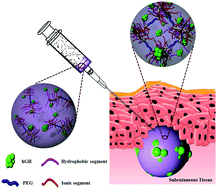Bioresorbable polypeptide-based comb-polymers efficiently improves the stability and pharmacokinetics of proteins in vivo
Abstract
Stimuli-responsive polypeptides are a promising class of biomaterials due to their tunable physicochemical and biological properties. Herein, a series of novel pH- and thermo-responsive block copolymers based on polypeptides were synthesized by ring-opening polymerization of γ-benzyl-L-glutamate-N-carboxyanhydride in the presence of poly(ethylene glycol)-diamine macroinitiator followed by aminolysis. The resulting polypeptide-based triblock copolymer, poly[(2-(dibutylamino)ethyl-L-glutamate)-co-(γ-benzyl-L-glutamate)]-poly(ethylene glycol)-b-poly[(2-(dibutylamino)ethyl-L-glutamate)-co-(γ-benzyl-L-glutamate)] (PNLG-co-PBLG-b-PEG-b-PBLG-co-PNLG), exists as a low viscous sol at low pH and temperature (≤pH 6.4, 25 °C) but it transforms to a soft gel under physiological conditions (pH 7.4 and 37 °C). The physical properties of the polypeptide gel can be tuned by controlling the ratio between hydrophobic PBLG and pH-sensitive PNLG blocks. The polypeptide-based copolymer did not show any noticeable cytotoxicity to fibroblast cells in vitro. It was found that subcutaneous injection of the polypeptide copolymer solution into the dorsal region of Sprague–Dawley (SD) rats formed a gel instantly without major inflammation. The gels were completely biodegraded in six weeks and found to be bioresorbable. Human growth hormone (hGH)-loaded polypeptide-based biodegradable copolymer sols readily formed a viscoelastic gel that inhibited an initial burst and prolonged the hGH release for one week. Overall, due to their bioresorbable and sustained release protein characteristics, polypeptide hydrogels may serve as viable platforms for therapeutic protein delivery and the surface tunable properties of polypeptide hydrogels can be exploited for other potential therapeutic proteins.



 Please wait while we load your content...
Please wait while we load your content...